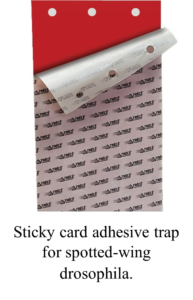It’s that time of year to make sure you have all your fruit insect monitoring tools on hand and ready to place out in the orchard. Whether you’re already experienced, or just learning how to use insect monitoring tools, they can be big a help in detecting the presence and activity of important pest insects during the production season. This is due in large part to the use of key attractants (smells, colors, and even shapes) in monitoring traps, which the pests simply cannot resist. When they arrive to check things out, they are captured and remain in the trap for you to spot! By tracking the number and seasonal trends of pests in monitoring traps, you can make an informed decision about the need to take action to protect your crop!
Many readers in our region likely use monitoring traps for pest insects such as codling moth, Oriental fruit moth and plum curculio (which are all tree fruit pests), as well as small fruit (berry) pests like spotted-wing drosophila. Although there several other insect pests that some of you monitor and manage based on specific fruit crops you grow, I wanted to bring your attention to the availability of new monitoring tools available for two of the more common pests I mentioned above: 1) codling moth (Cydia pomonella), and 2) spotted-wing drosophila (Drosophila suzukii).
Let’s start with codling moth, since you’ll want to be ready to start monitoring the adult moths soon! Several new Trécé brand lures are available for use with monitoring traps, and the key differences you’ll find with these particular lures are their longevity and the addition of chemical odors besides the pheromone, either to enhance attraction or for use as a complement to mating disruption. The new Trécé codling moth lures have a field life of 12 weeks, which is much longer than other lures, which last for 4-6 weeks in the field. Additionally, the new lures look a bit different from the gray or orange rubber septa you may be used to seeing – instead they are small black squares made from PVC. Finally, although these new lures have a longer field life, they are a bit more expensive: a single, basic pheromone lure will cost $5-$6, depending on the quantity you purchase, while the standard rubber septum lures that last 4-6 weeks cost just under $2 each.
Shifting to small fruit, the new monitoring trap for spotted-wing drosophila (SWD) is quite different – it’s a red sticky card, used in tandem with a lure that lasts for 4-6 weeks! For those who are familiar with this pest and our efforts to monitor it in Indiana blueberry orchards over the last several years, we’ve monitored the adult flies using a large peanut butter jar-style trap that has liquid in the bottom and a lure hanging from the lid inside. The flies are attracted to the lure and enter through small holes in the container, where they eventually fall into the liquid and drown. These traps work well, and the containers can be reused for years with care, but you must collect the liquid and sort through it to identify SWD adults, which does entail a bit of handling time. The new traps eliminate the need for drowning solution to trap the flies; instead, SWD flies will stick to the card when they land and that’s where you can spot the male flies, by using a magnifying glass or hand lens to look for the diagnostic spots on the tips of the wings. Just be sure to keep your hair away from the sticky trap! The cost of the new SWD sticky-card traps is less than the jar-style trap, but keep in mind that the sticky cards must be replaced more often, so the final cost will depend on your use of the materials. The lures are within $1 of each other in terms of cost, but some last 4 weeks, while others last 4-6 weeks. We will be evaluating these new monitoring traps this season and will compare them to the standard jar-style trap to see if we find any differences in date of first detection and total number captured over the season. Stay tuned for updates on what we learn! You can find these products and more details about prices at Great Lakes IPM.
Last but not least, thank you to all who responded to my survey with fruit insect topics you’d like to learn more about! You have been heard and I will highlight pests, like plum curculio, in future articles! If you didn’t have a chance to access the survey, you can still email suggested topics to me at eylong@purdue.edu.

